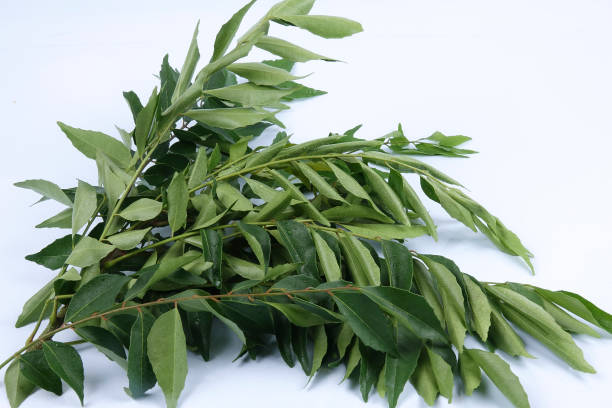

Bergera koenigii L.
|
Commonly known as Kaddi Patta belongs to the Rutaceae family. Leaves are used for seasoning and flavouring. Tender leaves are used in curry and also in making Pakodas in North-East India. A number of bioactive compounds are reported from this plant, out of them alkaloids like Girinimbine, Murrayamine J, Bismahanine, Murrayacine, Murrayaline, Murrrayastine are notable. Leaf extract showed immunomodulatory activity and signicantly down regulated IL-6, proinflammatory cytokine IL-1β and immunosuppressive cytokine IL-10 in serum levels of 4T1 breast cancer cell challenged mice. Mode of Consumption : Cooked, seasoning and flavouring |
| Plant Details | Agro-climatic Zone | Vernacular Names | Pictures |
| Scientific Name: Bergera koenigii L. Family: Rutaceae Juss. Class: Magnoliopsida Order: Sapindales Genus: Bergera J.Koenig ex L. Fruiting Season: April to November Parts: Leaves |
|
Andhra Pradesh : Karepaku Assam : Narasingha, Bishahari Bihar : Karipatta, Mitha neem, Gandhela, Barsanga Delhi : Karipatta, Mitha neem, Gandhela, Barsanga Gujarat : Mitho limado, Goranimb, Kadhilimbdo Haryana : Karipatta, Mitha neem, Gandhela, Barsanga Jharkhand : Karipatta, Mitha neem, Gandhela, Barsanga Karnataka : Karivebu Kerala : Kariveppilei, Kareapela Madhya Pradesh : Karipatta, Mitha neem, Gandhela, Barsanga Maharashtra : Karhinimb, Poospala, Gandla, Jhirang, Karipat, Karhi Odisha : Barsan, Basango, Bhursunga Rajasthan : Karipatta, Mitha neem, Gandhela, Barsanga Sikkim : Karipatta Tamil Nadu : Kariveppilai, Karivempu, Karuveppilei, Kattuveppilei Telangana : Karepaku, Karuvepaku Uttar Pradesh : Karipatta, Mitha neem, Gandhela, Barsanga Uttarakhand : Karipatta, Mitha neem, Gandhela, Barsanga West Bengal : Barsanga, Kariaphulli |
 Leafy twig |
| Compound/Extract | Activity | Mode of Action | Marker/References |
| Murrayanine | Anti-inflammatory | Murrayanine decreased NO, TNF-α and IL-6 production in both lipopolysaccharide stimulated RAW 264.7 cells and murine peritoneal macrophages. Also inhibited pro-inflammatory cytokines (TNF-α and IL-6) secretion in s LPS-challenged mice. | NO, TNF-α and IL-6[1] |
| Aqueous extract | Antioxidant, Hepatoprotective | Treatment with aqueous extract reduced the levels of TNF-α and NO in dose dependent manner in the liver of BALB/c mice. | NO and TNF-α[2] |
| Murrayakonine A, O-methylmurrayamine A and Mukolidine | Anti-inflammatory | Murrayakonine A, O-methylmurrayamine A and Mukolidine inhibited TNF-α and IL-6 release in a dose-dependent manner in vitro and reduced LPS induced TNF-α and IL-6 production in human PBMCs. | TNF-α and IL-6[3] |
| Aqueous and Methanolic leaf extract | Immunomodulatory | Pro-inflammatory cytokines like TNF-α and IL-2 were down-regulated and the anti-inflammatory cytokines, IL-4 and IL-10 levels were increased in leaf extract-treated (Aqueous & Methanolic) mice when compared with diabetic mice after 30 days of treatment. | TNF-α, IL-2, IL-4 and IL-10[4] |
| Leaf extract | Immunomodulatory | Leaf extract treatment reduced the inflammatory mediator IL-6, proinflammatory cytokine IL-1β and immunosuppressive cytokine IL-10 in serum levels of 4T1 breast cancer cell inoculated mice. | IL-6, IL-1β, and IL-10[5] |
| Major Class | Metabolites (Content of bioactives: mg/100g Fresh Weight) |
| Murrayakonine A: , Murrayanine: [1] | |
| Alkaloid | Bismahanine: , Euchrestine : , Girinimbine: , Murrayacine: , Murrayaline: , Murrayamine J: , Murrayastine: , O- methyl mahanine: , O-methyl murrayamine A : , Pypayafolinecarbazole: [8] |
| Carboxylic Acid | Ferulic acid: 0.281 ± 0.055 mg/g DW (Kelantan), Gallic acid: 0.933 ± 0.076 mg/g , DW (Kelantan), 0.904 ± 0.040 mg/g DW (Selangor), 0.813 ± 0.065 mg/g DW (Johor), Mukoeic acid: , Vanillic acid: 0.788 ± 0.103 mg/g DW (Kelantan), 0.659 ± 0.058 mg/g DW (Selangor), 0.527 ± 0.111 mg/g DW (Johor)[9] |
| Carotenoid | Lutein: [8] |
| Coumarine | Murrayone imperatoxin: [8] |
| Flavonoid | Catechin : 0.204 ± 0.032 mg/g DW (Johor), 0.245 ± 0.044 mg/g DW (Selangor), 0.325 ± 0.057 mg/g DW (Kelantan), Myricetin: 0.703 ± 0.063 mg/g , DW (Kelantan), 0.600 ± 0.078 mg/g DW (Selangor), 0.502 ± 0.040 mg/g DW (Johor), Naringin: 0.203 ± 0.036 mg/g DW (Kelantan), Quercetin: 0.305 ± 0.028 mg/g DW (Johor), 0.341 ± 0.0150 mg/g DW (Selangor), 350 ± 0.024 mg/g DW (Kelantan), Rutin: 0.042 ± 0.008 mg/g DW (Kelantan) , 0.048 ± 0.009 mg/g DW(Johor) , 0.082 ± 0.011 mg/g DW (Selangor)[9] |
| Heterocyclic Compound | Epicatechin: 0.601 ± 0.050 mg/g DW (Selangor), 0.678 ± 0.032 mg/g DW (Kelantan), Isomahanine : , Koenimbine : , Mahanimbine: , Mahanine: , Murrayazoline: , Phebalosin: [8] |
| Organic heterotricyclic compound | Bicyclomahanimbicine: , Bismurrayafoline E: , Koenigine: , Koenine: , Mahanimbicine: , Mukolidine: , Murrayazolidine: [8] |
| Phenolic acid | Cinnamic acid: 0.077 ± 0.021 mg/g DW (Selangor), 0.068 ± 0.019 mg/g DW (Johor)[9] |
| Terpene | Carotene : [8] |
| Triterpenoid | Cyclomahanimbine: , Tetrahydromahanmbine: [8] |
| Effect | Observation | DOI |
| Disease | Formulation | Reference | Author | TKDL |
| Information from Wealth of India | Reference |
|
CSIR(1962).The Wealth of India, Raw materials,Vol.-VI ,P.446-447, New Delhi, India |
| 4.2, 4.2.1, 4.2.1.1, 4.2.1.3, 4.2.2.5, 4.2.2.8, 4.2, 4.2.1, 4.2.1.1, 4.2.1.3, 4.2.2.5, 4.2.2.8 |
| CSIR-North East Institute of Science and Technology, Jorhat-6, Assam, India
CSIR-Institute of Himalayan Bioresource Technology, Palampur-61,Himachal Pradesh, India |